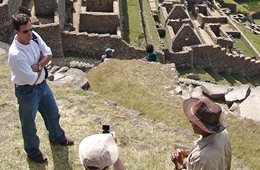
Climbing Machu Picchu affords time to ponder what life was like during the heyday of the vast Inca Empire. Though the Inca rulers left no written records, the ruins of their civilization and first-hand account of their Spanish conquerors do give us several excellent hints. Class and caste conscious to an almost obsessive degree, the Inca were a highly-organized society with complex and sophisticated approaches to government, military conquest, and civil society.
The actual purpose of Machu Picchu itself is unclear. Was it perhaps a temple to one of the gods the Inca worshipped? We do know that the extreme climatic conditions of the Peruvian Andes inspired a religion with gods who represented and controlled natural phenomenon such as storms, the sea, and fertility. Aspects of the Inca religion bear uncanny resemblances to both the Greco-Roman tradition, with gods such as Inti personifying the sun, and his sister-wife, Mama Quilla, the moon, and also to the Judeo-Christian flood and creation narratives.
Winning the favor of the gods - particularly Viracocha, the creator of the universe and his son Inti, the all-important sun god - was a key focus of Inca religious practices, and in times of emergency such as war or famine they resorted to both cannibalism and ritual child sacrifice. Important citizens were mummified, after death, their corpses brought out and fed and feted during major festivals and religious holidays.
The solar-centric religion of the Incas made them astute astronomers: many major festivals were held on solstices and equinoxes, and their solar and lunar calendars were highly accurate instruments not only for worship, but for more practical aspects of life such as agricultural cycles.
How, then, did Machu Picchu fit in to this highly evolved civilization? Was it part, as some scholars suggest, of a chain of temples, linked together by the Inca Trail pilgrimage road? Was it a military fortress or garrison? Was it a place of ritual sacrifice, or astronomical study? Was it simply a suburban retreat for the semi-divine royal family from the hurly burly of Cuzco, much like Windsor Castle or Versailles? Or was Machu Picchu a little bit of each of these?
Alexander+Roberts offer a wide variety of options to visit Machu Picchu and other Inca sites in Peru including our comprehensive
Peru Explorer.